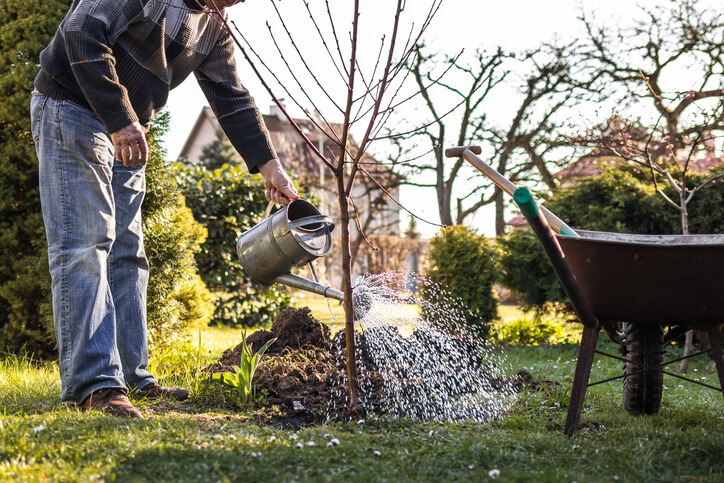Fruit tree planting is one of the greatest joys for Seattle lawn owners. Planting a fruit tree in your backyard comes with numerous benefits: It allows you to promote your wellbeing with healthy and organic foods, rewild natural lands, protect wildlife, and more.
However, planting fruit trees also comes with certain challenges, as not all homeowners know how to plant or take care of new fruit trees properly. After all, it requires proper and regular maintenance to enjoy the benefits mentioned above.
In this fruit tree planting guide, we will cover all aspects of planting a fruit tree and how to take care of one.

How to Plant Fruit Trees the Right Way
Regardless of what type of fruit tree you want for your garden, there are two buying options – container-grown and bare-root trees. Each comes with its perks and downsides that you should consider when looking to plant fruit trees.
Bare-Root vs. Container-Grown Trees
Container-Grown Trees
The container-grown trees are usually available in late spring and are more expensive to purchase. Only limited varieties are available for purchase, which isn’t a big problem for those who want to plant fruit trees for the first time.
Container-grown plants might not be the best option for those who already have a few fruit trees in their backyards and are looking for new species or types. They are also rootbound at the time of purchase, which can be a challenge for first-time planters, and tend to cultivate root girdling a few years after planting.
The container-grown trees perform well in the fall.
Bare-Root Trees
The bare-root trees are more cost-effective than container-grown trees and offer a wide selection of fruit tree varieties and types. They are available to purchase in the late winter and plant in early spring.
It is essential to plant them before they break dormancy and start growing and flourishing for the upcoming season.
Once you decide which option is better for you, it is good to know what to look for in a specimen when you go shopping. For example, when buying container-grown trees, choose those with no bark damage, have good leaf color, and no signs of disease. For bare-root fruit trees, look for ones with healthy roots and no visible breakage.
Choose a Planting Site
The next thing you should do is find a planting site that fulfills the following requirements:
- Has a direct exposure to the sun (fruit trees need 6-8 hours of sunlight to produce fruit)
- Has well-drained soil and pH from 6.0 to 7.5
- Enough space for the tree to develop and grow
- Provides protection from strong winds
Planting Guide for Fruit Trees: Step-by-Step Instructions
Before starting with fruit tree planting, ensure you have all the necessary tools, including shovel or garden fork, hammer, ties for tree support, and fencing.
Step 1: Dig a Hole
Using a shovel, dig a hole that is larger than the root system of the tree. Ideally, your hole should be two to three times as wide as the tree’s roots and two to three inches deeper. Don’t add fertilizer because it may encourage the roots to stay passive instead of spreading.
If necessary, you can loosen the sidewalls of the hole. That way, the roots will penetrate the soil and promote faster and healthier tree growth.
Step 2: Remove the Labels
The next thing you should do is remove the labels to prevent girdling of the trunk as it develops and grows larger.
Step 3: Place the Tree
It is vital to place the tree at the correct depth. Some Seattle homeowners plant their fruit trees too deeply, and it impacts proper growth.
Ideally, you should place the roots in the hole so the rootstock is slightly above the soil line.
Step 4: Fill the Hole
Next, tamp the soil down slowly and carefully with your foot to even the surface.
Step 5: Establish Support
Each newly planted fruit tree requires staking for at least two years until the trunk is strong enough to provide support. Using a hammer, establish the tree support from the tree trunk to the edge of the hole.
Fruit Tree Care: How To Take Proper Care of Your New Fruit Tree
Enjoying healthy and beautiful fruit trees comes with a lot of responsibilities. Here are some of the basic fruit tree care tips to keep in mind.
Water the Tree Regularly
All fruit trees need water immediately. Pour 2-5 gallons of water slowly and let the roots absorb the liquids before adding more.
If necessary, add more soil, especially if you notice any air pockets.
After seven days, water the tree once a week.
Mulch Around the Base
Mulching yields numerous benefits. With regular mulching, you will reduce competition that slows your tree’s development, minimize weeds, and balance soil moisture. Ideally, you should mulch around the base at a distance of approximately three feet from the trunk’s bottom.
Protect the Tree from Animals
Until it grows into a solid and high tree, you have to protect the plant from rabbits, deer, and other nearby animals. Chicken wire is an excellent solution to keep animals away.
Prune Your Fruit Tree
Pruning stimulates root growth, and when it comes to newly planted fruit trees, you should prune to a height of 30-35 inches.
When Should You Plant Fruit Trees
The best period to plant fruit trees is early in the spring, after their dormant phase. Some Seattle homeowners say that trees planted in April have better chances of thriving than those planted a month later.
You may also plant some trees in the fall, but spring is still a better period as it protects fruit trees from the freezing winter temperatures.
Planting Fruit Trees: Conclusion
Planting fruit trees is fun. However, if you haven’t done it before, you may find the process time-consuming and challenging. It may help if you follow the fruit trees planting guide, but if you still have trouble navigating through the planting stage, you can count on us to help.
Lineage Tree Care is a fruit tree planting partner you can depend on. We have the experience, industry knowledge, and tools to plant and maintain all types of fruit trees that thrive in Seattle, WA.
Contact us today at 425-800-8023 to get a free quote and learn more about the services we offer.
